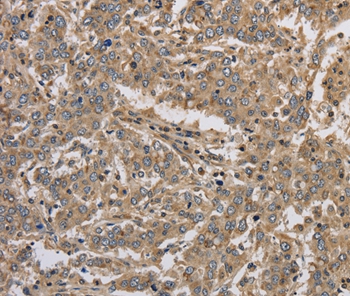
The image is immunohistochemistry of paraffin-embedded Human brain tissue using CSB-PA140706(KCNMB3 Antibody) at dilution 1/40. (Original magnification: x200)
KCNMB3 Antibody
CSB-PA140706
ApplicationsWestern Blot, ELISA, ImmunoHistoChemistry
Product group Antibodies
ReactivityHuman, Mouse
TargetKCNMB3
Overview
- SupplierCusabio
- Product NameKCNMB3 Antibody
- Delivery Days Customer20
- ApplicationsWestern Blot, ELISA, ImmunoHistoChemistry
- CertificationResearch Use Only
- ClonalityPolyclonal
- ConjugateUnconjugated
- Gene ID27094
- Target nameKCNMB3
- Target descriptionpotassium calcium-activated channel subfamily M regulatory beta subunit 3
- Target synonymsBKBETA3, HBETA3, K(VCA)BETA-3, KCNMB2, KCNMBL, SLO-BETA-3, SLOBETA3, calcium-activated potassium channel subunit beta-3, BK channel beta subunit 3, BK channel subunit beta-3, MaxiK channel beta-subunit 3, big potassium channel beta subunit 3, calcium-activated potassium channel regulatory subunit, calcium-activated potassium channel, subfamily M subunit beta-3, charybdotoxin receptor subunit beta-3, large conductance, voltage and Ca2+ activated potassium channel Maxi K beta 3 subunit, maxi K channel subunit beta-3, potassium channel subfamily M regulatory beta subunit 3, potassium large conductance calcium-activated channel, subfamily M beta member 3
- HostRabbit
- IsotypeIgG
- Protein IDQ9NPA1
- Protein NameCalcium-activated potassium channel subunit beta-3
- Scientific DescriptionMaxiK channels are large conductance, voltage and calcium-sensitive potassium channels which are fundamental to the control of smooth muscle tone and neuronal excitability. MaxiK channels can be formed by 2 subunits: the pore-forming alpha subunit and the modulatory beta subunit. The protein encoded by this gene is an auxiliary beta subunit which may partially inactivate or slightly decrease the activation time of MaxiK alpha subunit currents. Alternative splicing results in multiple transcript variants. A related pseudogene has been identified on chromosome 22.
- ReactivityHuman, Mouse
- Storage Instruction-20°C or -80°C
- UNSPSC41116161




